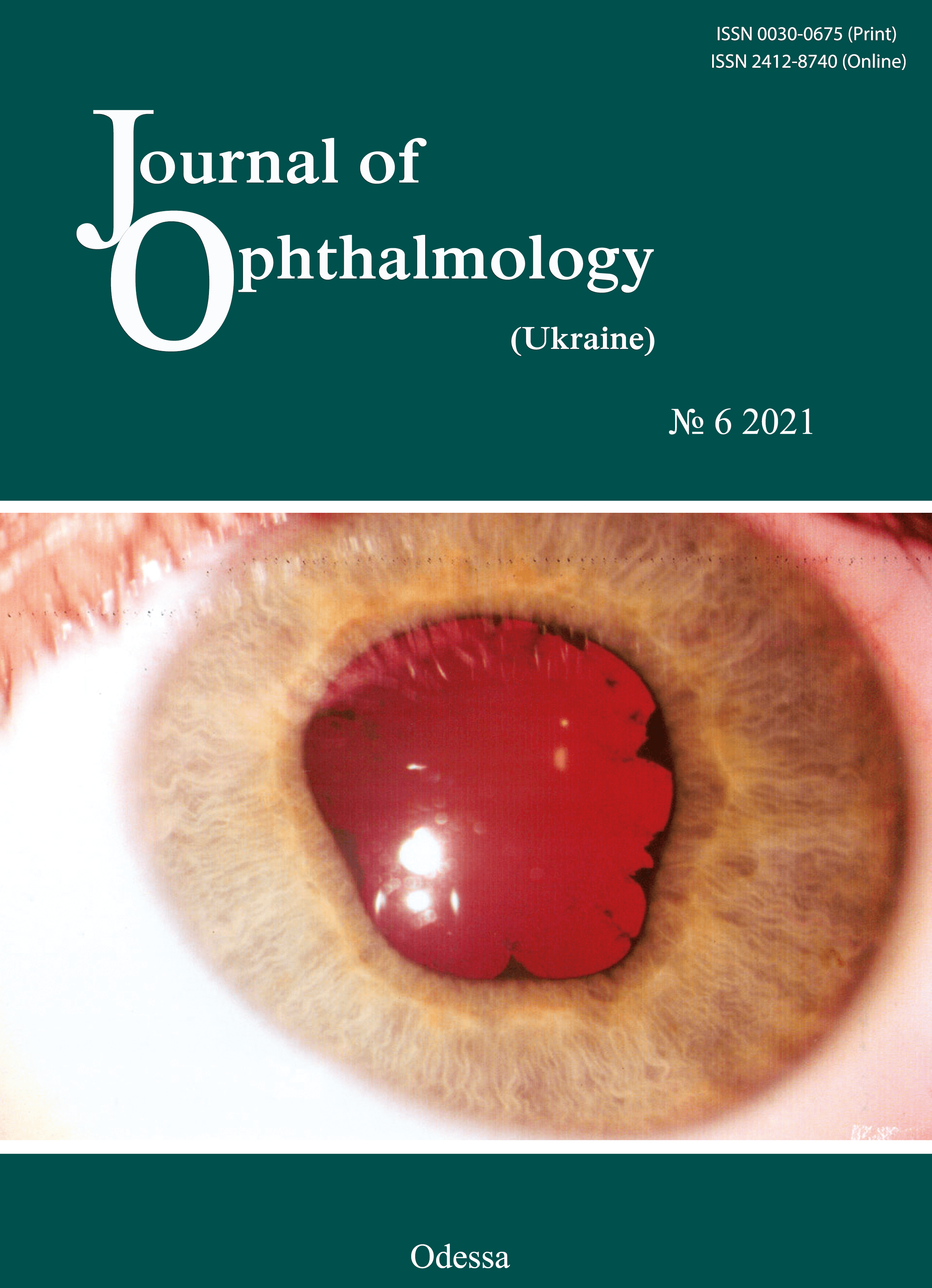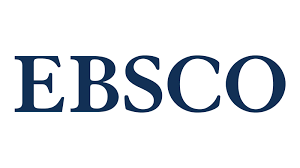Visual outcome following cataract surgery in children of 2 months to 16 years age: a prospective study in a tertiary eye care center
DOI:
https://doi.org/10.31288/oftalmolzh20216815Ключові слова:
сhildhood cataract, visual acuity, YAG capsulotomy, amblyopiaАнотація
Background. Childhood cataract is an important cause of blindness in children and imposes a huge socio economic burden on society.
Purpose. Aim of the study is to identify the visual outcome after cataract surgery in paediatric age group and to study the various factors which influence visual outcome and surgical complications in paediatric cataract surgery.
Material and Methods. This prospective study conducted at a tertiary Eye care Hospital for the period of September 2016 to February 2017. 30 children who presented with developmental cataract or congenital cataract in the age group of 2months – 16 years included in this study. Visual acuity in children less than 5 years was assessed using picture chart, E charts and Cardiff acuity cards and by snellen’s chart for >5 years age children. Biomicroscopy, Fundus examination, and A scan were done. Children were reviewed every day for first day and then every week for first month and every 3 months for the first year after cataract surgery.
Results. There were males (56.67%) dominance. Visual Inattentiveness/ defective vision was observed in 29(64.4%) of eyes. 13(33%) children had consanguity. Most of them were bilateral 26 (87%). Nystagmus was found to be the most common6 (20%) associated ocular anomaly. Vision at the time of presentation was less than 6/60 in better eye in 30 eyes (66.66%). Commonest type of cataract was total cataract 20(44.44%), followed by lamellar cataract 10 (22.22%). 45 eyes were operated, and IOL was implanted 73.33% of the eyes. Posterior capsulotomy with or without anterior vitrectomy was done in children less than 8 years of age. Following retinoscopic refraction, children were prescribed bifocal spectacles. Aphakic spectacles were prescribed in needed cases. Visual outcome at the end of 6 weeks was found to be greater than 6/24 in 66.66%. At the end of 12 months, vision greater than 6/24 was 48.88%. Posterior Capsule Opacification (PCO) was thick enough to require capsulotomy in 4 eyes. 3 Children underwent YAG capsulotomy. 1 eye needed surgical membranectomy. Complications other than PCO that was noted in this study were amblyopia which was seen in 5 eyes and optic capture in 2 eyes, anterior synaechiae in 1 eye and vitreous haemorrhage in 1 eye.
Conclusion. Children less than 8 years who underwent primary posterior capsulotomy with or without anterior vitrectomy showed good visual outcome. PCO is the commonest complication and a major cause for visual obscuration following surgery, though the incidence of PCO has been brought down with modified surgical techniques and newer IOL designs. Children who underwent YAG/surgical capsulotomy had significant visual gain. Children with amblyopia who had strict adherence to occlusion therapy had significant improvement in visual acuity.
Посилання
1.Taylor HR. Refractive errors - Magnitude of the Need. J Community Eye Health 2000;13:1-2.
2.World Health Organization. Prevention of blindness and deafness.Global Initiative for the Elimination of Avoidable Blindness. WHO Document WHO/PBL/97.61 Rev 2. Geneva: WHO; 2000.
3.Gilbert CE, Canovas R, Hagan M, Rao S, Foster A. Causes of childhood blindness: Results from west Africa, south India and Chile. Eye (Lond) 1993;7(Pt 1):184-8. https://doi.org/10.1038/eye.1993.39
4.Dandona L, Williams JD, Williams BC, Rao GN. Population-based assessment of childhood blindness in southern India. Arch Ophthalmol 1998;116:545-6.
5.Rahi JS, Sripathi S, Gilbert CE, Foster A. Childhood blindness in India: Causes in 1318 blind school students in nine states. Eye(Lond) 1995;9(Pt 5):545-50.https://doi.org/10.1038/eye.1995.137
6.Giles K, Cristelle D,Y annick B, Fricke OH, Wiedemann P (2016).Cataract surgery with intraocular lens implantation in children aged 5-15 in local anaesthesia:visual outcomes and complications.Pan Afr.Med J;24:200.https://doi.org/10.11604/pamj.2016.24.200.9771
7.Ma F, Wang Q, Wang L. Advances in the management of the surgical complications for congenital cataract. Front Med. 2012; 6(4):360-5.https://doi.org/10.1007/s11684-012-0235-1
8.Clare G (2009).Worldwide causes of blindness in chidren, in: Paediatric Ophthalmology: Current Thought and A Practical Guide. Springer, Berlin: 47-60
9.Khanna RC, FosterA, KrishnaiahS, MehtaMK, GogatePM. Visual outcomes of bilateral congenital and developmental cataracts in young children in south India and causes of poor outcome.Indian J Ophthalmol 2013;61:65-70. 1. Gilbert C. New issues in childhood blindness. Commun Eye Health J. 2001;14:53-56PPMID: 17491932 https://doi.org/10.4103/0301-4738.107194
10.Nikhil R, ShubhiT, AnushreeKA, SudhirT, MadanD. Evaluation of visual outcomes after paediatric cataract surgery in a tertiary eye care hospital in western Maharashtra. J Clin Ophthalmol Res 2016;4:13-8.https://doi.org/10.4103/2320-3897.174345
11.Thakur J, Reddy H, Wilson ME Jr, Paudyal G, Gurung R, Thapa S, Tabin G, Ruit S. Pediatric cataract surgery in Nepal. J Cataract Refract Surg. 2004; 30(8):1629-35.https://doi.org/10.1016/j.jcrs.2003.12.047
12.BarSela SM, Spierer A. Astigmatism outcomes of scleral tunnel and clear corneal incisions for congenital cataract surgery. Eye (Lond)2006;20:1044 8.https://doi.org/10.1038/sj.eye.6702082
13.Chaudary S et al, Visual outcome of Paediatric Cataract surgery, Nepal J Ophthalmol 2017;Vol 9(18): 143-148 https://doi.org/10.3126/nepjoph.v9i2.19258
14.Damaris Magdalene et al. Pediatric cataract blindness management and outcomes in North East India hospital based study Damaris Magdalene 1 , Indian Journal of Clinical and Experimental Ophthalmology, January-March,2017;3(1): 112-114
15.Shah MA, Shah SM, Appleware AH, Patel KD, Rehman RM, Shikhange KA, et al. Visual outcome of traumatic cataract in pediatric age group. Eur J Ophthalmol 2012;22:956 63. https://doi.org/10.5301/ejo.5000111
16.Brar GS, Grewal DS, Ram J, Singla M, Grewal SP. Square-edge polymethylmethacrylate intraocular lens design for reducing posterior capsule opacification following paediatric cataract surgery: initial experience. Clinical & experimental ophthalmology. 2008 Sep;36(7):625-30.https://doi.org/10.1111/j.1442-9071.2008.01818.x
17.Hirachan A, Bajracharya K, Rai SK, Bhari AM, Chandra A. Visual outcome of congenital and developmental cataract surgery in Lumbini Eye Institute. Asian Journal of Medical Sciences. 2018 Mar 1;9(2):36-9.https://doi.org/10.3126/ajms.v9i2.18780
18.Gurung RL, Adhikari S, Shrestha UD, Ruit S. Outcome of Paediatric Cataract Surgery at Tilganga Institute of Ophthalmology, Nepal. Birat Journal of Health Sciences 2018;3(1)5 : 331-337.https://doi.org/10.3126/bjhs.v3i1.19730
##submission.downloads##
Опубліковано
Як цитувати
Номер
Розділ
Ліцензія
Авторське право (c) 2025 N. Deepthi Slesser, Nasrin Y., P. Krishna Prasad

Ця робота ліцензується відповідно до Creative Commons Attribution 4.0 International License.
Ця робота ліцензується відповідно до ліцензії Creative Commons Attribution 4.0 International (CC BY). Ця ліцензія дозволяє повторно використовувати, поширювати, переробляти, адаптувати та будувати на основі матеріалу на будь-якому носії або в будь-якому форматі за умови обов'язкового посилання на авторів робіт і первинну публікацію у цьому журналі. Ліцензія дозволяє комерційне використання.
ПОЛОЖЕННЯ ПРО АВТОРСЬКІ ПРАВА
Автори, які подають матеріали до цього журналу, погоджуються з наступними положеннями:
- Автори отримують право на авторство своєї роботи одразу після її публікації та назавжди зберігають це право за собою без жодних обмежень.
- Дата початку дії авторського права на статтю відповідає даті публікації випуску, до якого вона включена.
ПОЛІТИКА ДЕПОНУВАННЯ
- Редакція журналу заохочує розміщення авторами рукопису статті в мережі Інтернет (наприклад, у сховищах установ або на особистих веб-сайтах), оскільки це сприяє виникненню продуктивної наукової дискусії та позитивно позначається на оперативності і динаміці цитування.
- Автори мають право укладати самостійні додаткові угоди щодо неексклюзивного розповсюдження статті у тому вигляді, в якому вона була опублікована цим журналом за умови збереження посилання на первинну публікацію у цьому журналі.
- Дозволяється самоархівування постпринтів (версій рукописів, схвалених до друку в процесі рецензування) під час їх редакційного опрацювання або опублікованих видавцем PDF-версій.
- Самоархівування препринтів (версій рукописів до рецензування) не дозволяється.












